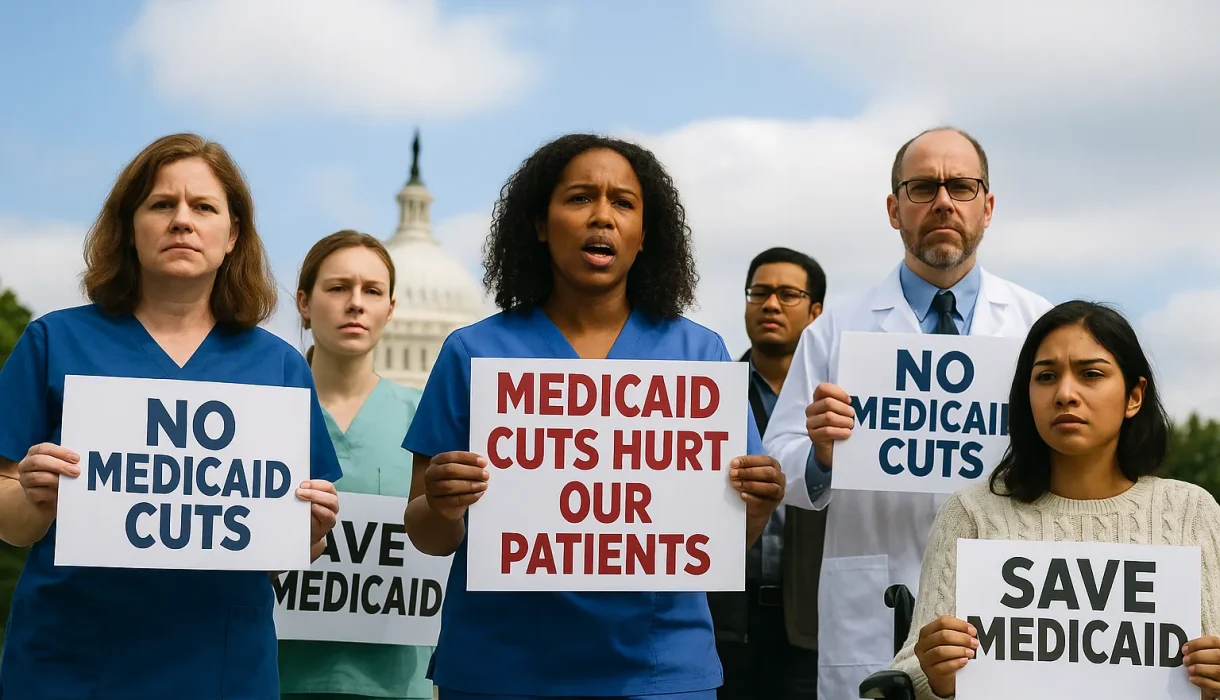
Ripple Effects: How GOP Medicaid Cuts Ignite a 2025 Political Firestorm.
Posted in :
The GOP’s sweeping Medicaid cuts—part of Trump’s “big, beautiful bill”—are sparking public backlash, internal GOP retirements, and a reinvigorated Democratic campaign strategy. With 11.8 million Americans at risk of losing coverage, Republicans face mounting pressure ahead of the 2025 elections. For many, this could be a political reckoning.
The sweeping Medicaid cuts delivered by the GOP’s signature 2025 legislation have Republican lawmakers scrambling, with internal dissent and external backlash threatening the party’s hard-fought House majority. As millions face risk of losing healthcare, Democrats are poised to leverage the controversy in the upcoming elections, reviving campaign strategies from past partisan battles.
It’s funny how one vote can change the heat in a room. Years ago at a tense dinner party, my uncle confessed he’d voted for a bill that later cost him his seat on the city council. The awkward silence was so thick you could slice it. That memory ricocheted through my mind as news broke about the GOP’s freshly-passed Medicaid cuts. Republican lawmakers now face a similarly frosty reception back home—and this time, the stakes are national. With the 2025 elections looming, the consequences of Trump’s so-called ‘big, beautiful bill’ are rippling through both Congress and the kitchen tables of regular Americans.
After the ‘Big, Beautiful Bill’: GOP Lawmakers Face the Music
The passage of Trump’s “big, beautiful bill” has sent shockwaves through the ranks of Republican lawmakers, especially those in swing districts. With $1.7 trillion in federal program cuts—more than $1 trillion of that from healthcare and Medicaid—many in the GOP are now bracing for a political backlash that could threaten their already slim House majority in the 2025 elections.
Mounting Medicaid Bill Concerns
At the heart of the anxiety are the GOP Medicaid cuts, which are estimated to push nearly 11.8 million Americans off their health insurance. The numbers are stark: $1 trillion slashed from healthcare programs, with Medicaid taking the brunt. For many Republican lawmakers, especially those representing districts with high Medicaid enrollment, the risk is not just policy—it’s personal job security.
Sen. Jim Justice (R-W.Va.) put it bluntly in a recent interview:
“You would be foolish not to worry about it… If you don’t keep the voters right with you, you’re going to awaken to a bad, bad, bad day.”
Justice’s warning is echoed across the party, as lawmakers recall the 2018 midterm elections, when Republicans lost 40 House seats after their failed attempt to repeal the Affordable Care Act. That loss still haunts GOP strategists, serving as a cautionary tale about the dangers of tampering with healthcare coverage.
Electoral Flashbacks and Fresh Fears
The parallels to 2018 are hard to ignore. Back then, Democrats capitalized on Republican efforts to cut health programs, flipping dozens of seats—including some in Trump-leaning districts. Now, Democrats are preparing to use the Medicaid bill concerns as a central theme in their 2025 campaign messaging, aiming to tie vulnerable Republicans to the unpopular cuts.
Polling reflects the challenge ahead for the GOP. Surveys from Quinnipiac, The Washington Post, Pew Research, and Fox News show that voters disapprove of the “big, beautiful bill” by a 2-to-1 margin. Nearly half of respondents want more federal funding for Medicaid, while only 10 percent support cuts. As Republican pollster Whit Ayres notes:
“What we know from past elections is that messing with people’s healthcare coverage is very problematic for politicians. And it has, in the past, yielded some very, very negative views about the people who supported it.”
Public Anxiety and Political Fallout
The anxiety isn’t just theoretical. Some lawmakers have chosen to retire rather than defend the Medicaid cuts. North Carolina’s Thom Tillis, a vulnerable GOP senator, announced his retirement after warning colleagues he would lose his seat over the bill. Maine’s Susan Collins opposed the measure, citing its “harmful impact” on low-income families and rural health providers. Rep. Don Bacon, facing a tough re-election in Nebraska, openly voiced his concerns about cuts to food aid and Medicaid before announcing his own retirement.
Others, like Rep. Brian Fitzpatrick (R-Pa.), voted against the bill, citing the risk to over 100,000 Medicaid enrollees in his district. Rep. David Valadao (R-Calif.), who lost his seat in the 2018 healthcare backlash and won it back in 2020, supported the bill but expressed “several concerns” about its stricter Medicaid limits. His Central Valley district, with the highest percentage of Medicaid enrollees in the GOP conference, is again a top Democratic target.
GOP House Majority Threats Loom
Republican leaders are now walking a tightrope. House Speaker Mike Johnson privately warned that the Senate’s deeper cuts could cost the party its majority, but still pushed members to support the changes. The GOP’s messaging strategy leans on popular provisions—like eliminating taxes on tips—while trying to deflect attention from the unpopular Medicaid reductions.
Some Republicans argue they are protecting the “most vulnerable” by targeting waste and fraud, but even they acknowledge the risks. As Rep. Russ Fulcher (R-Idaho) admitted, “If it’s just strictly a situation where you say, ‘We’re just cutting and spending’ and it’s not cognizant as to how and where, that’s where we get into trouble.”
With Democrats already rolling out ads and campaign attacks, the GOP Medicaid cuts have ignited a political firestorm. The fallout from Trump’s “big, beautiful bill” is just beginning, and for many Republican lawmakers, the music is only getting louder.
Voters, Villains, and Vintage Playbooks: How Democrats Plan to Exploit GOP Medicaid Cuts
The recent GOP-backed Medicaid cuts have set off alarm bells across the political spectrum, but it’s the Democrats who are seizing the moment with a familiar, battle-tested strategy. Drawing from their successful 2018 playbook, Democratic leaders and campaign strategists are tying vulnerable Republicans directly to the unpopular health care cuts, betting that public backlash will translate into electoral gains in 2025. This approach is grounded in both recent history and current public opinion, which overwhelmingly disapproves of the GOP’s approach to health care cuts.
Reviving a Winning Strategy: Lessons from 2018
In 2018, Democrats flipped the House by relentlessly focusing on Republican attempts to repeal the Affordable Care Act. Now, with the passage of a $1 trillion-plus cut to health care programs—including Medicaid—Democrats are preparing to run the same campaign. As CJ Warnke of House Majority PAC put it,
“Republicans are running back their 2018 playbook. And it’s once again going to cost them the majority.”
The parallels are striking. Vulnerable Republicans, especially those in swing districts with high Medicaid enrollment, are once again being painted as the villains responsible for stripping away health coverage from millions.
Public Opinion: A Potent Weapon
Research shows that public opinion is firmly against the GOP’s Medicaid cuts. According to recent Quinnipiac polling, there is a 2-to-1 margin of disapproval for the megabill, with nearly half of voters supporting more Medicaid funding and only 10% favoring less. This aligns with broader trends in voter reactions to Medicaid cuts: Americans are wary of reductions to safety-net programs, especially when those cuts threaten coverage for children, seniors, and people with disabilities.
Republican pollster Whit Ayres summed up the risk:
“What we know from past elections is that messing with people’s healthcare coverage is very problematic for politicians. And it has, in the past, yielded some very, very negative views about the people who supported it.”
Personal Stories and the Power of Narrative
Democratic strategies for GOP cuts are not just about numbers—they’re about people. Super PACs and candidates are flooding the airwaves with stories of real Americans who fear losing their coverage. House Minority Leader Hakeem Jeffries spent nearly nine hours on the House floor reading letters from constituents affected by the cuts, a move designed to put a human face on the consequences of the legislation.
- Jeffries: 8 hours, 45 minutes reading letters from those fearing lost coverage
- Super PACs rolling out attack ads in swing districts
- Focus on vulnerable groups: pregnant women, children, seniors, and people with disabilities
This narrative-driven approach is designed to stoke voter reactions to Medicaid cuts and keep the issue front and center as the 2025 elections approach.
Republican Response: Damage Control and Internal Dissent
Republicans are scrambling to reframe the debate, highlighting provisions in the bill that eliminate taxes on tips and extend Trump’s 2017 tax cuts. Yet, even within GOP ranks, there is unease. Some lawmakers, like Sen. Jim Justice (R-W.Va.), have warned that failing to keep voters on their side could lead to a “bad, bad, bad day” at the polls. Others, such as Rep. Brian Fitzpatrick (R-Pa.), voted against the bill, citing the negative impact on their Medicaid-heavy districts.
The party’s messaging is further complicated by high-profile retirements and public dissent. North Carolina’s Thom Tillis, for instance, announced his retirement after warning colleagues that Medicaid cuts would cost him his seat. Meanwhile, Democrats are confident that Republican attempts to “put shine on a turd” will not sway public opinion, as Democratic consultant Ian Russell bluntly put it.
Key Data Points: Public Opinion Healthcare Cuts
- Polls show 2-to-1 opposition to the GOP’s megabill
- Nearly half of voters want more Medicaid funding; only 10% want less
- Democratic campaign arms already rolling out attack ads focused on Medicaid cuts
The combination of strong public disapproval, compelling personal stories, and a proven campaign strategy gives Democrats a clear advantage as they aim to turn GOP Medicaid cuts into a central issue for 2025. The political firestorm is only beginning, but the battle lines are already clear.
Retirements, Revolts, and Red-State Headaches: The (Un)intended Consequences of Medicaid Cuts
The passage of sweeping Medicaid cuts in the GOP’s “big, beautiful bill” has set off a political chain reaction that few in Republican leadership seem able to control. What began as a legislative win for former President Trump is quickly transforming into a source of deep anxiety for Republican lawmakers, especially as the 2025 elections draw near. The Medicaid cuts impact is not just a policy debate—it’s a political firestorm that threatens to reshape the electoral landscape in ways the party may not have anticipated.
High-profile retirements are the first visible cracks. Senator Thom Tillis of North Carolina, a key Republican voice, decided to retire rather than face reelection after supporting the Medicaid bill. He warned colleagues that the Medicaid bill concerns would become a political albatross, much like the Affordable Care Act was for Democrats a decade ago. Similarly, Rep. Don Bacon from Nebraska, representing a swing district, announced his own retirement, citing the growing backlash over cuts to food aid and Medicaid. These retirements are not isolated incidents—they signal a broader internal stress within the party, as research shows that some Republicans are leaving Congress or publicly breaking with the party over Medicaid cuts.
The internal split is palpable. Some Republican lawmakers defend the cuts as necessary reforms, arguing that the changes are aimed at protecting “intended recipients” and rooting out waste and abuse. Rep. Mike Lawler (R-NY) summed up this position:
“At the end of the day, this is about strengthening the program.”
But others are scrambling to reassure voters that the most severe changes—like the controversial provider tax drawdown—won’t take effect until 2028, and may yet be rolled back. Rep. Russ Fulcher (R-Idaho) voiced the unease many feel:
“If it’s just strictly a situation where you say, ‘We’re just cutting and spending’ and it’s not cognizant as to how and where, that’s where we get into trouble.”
The Medicaid voter impact is especially pronounced in districts where Medicaid usage is high—often the very battlegrounds that will decide control of Congress. For example, Rep. Brian Fitzpatrick’s suburban Philadelphia district has over 100,000 Medicaid enrollees. In California’s Central Valley, Rep. David Valadao faces a district where nearly two-thirds of constituents rely on Medicaid. These are not outliers. Many deep-red regions, once considered safe for Republicans, now find themselves at the center of the Medicaid debate, with Democrats eager to weaponize the issue as they did in the 2018 midterms.
Polling underscores the risk. Surveys from Quinnipiac University and others show a 2-to-1 margin of disapproval for the GOP’s megabill, with nearly half of voters wanting more federal funding for Medicaid—not less. This widespread discontent is fueling Democratic strategies to tie vulnerable Republicans to the unpopular cuts, echoing the successful playbook that flipped 40 House seats in 2018. House Minority Leader Hakeem Jeffries and Democratic campaign arms are already hammering the message home, reading stories of constituents who stand to lose coverage and launching targeted ads in swing districts.
Republican lawmakers are left walking a tightrope. On one hand, they tout popular provisions like eliminating taxes on tips. On the other, they face mounting criticism for slashing safety-net programs by $1.7 trillion and potentially kicking millions off their health plans. Some, like Rep. Lawler, insist the bill can be explained and defended, but the party’s internal divisions and the reality of district-level Medicaid dependency make that a tough sell.
Ultimately, the Republican lawmakers electoral risks are real and growing. The combination of retirements, public revolts, and the unique vulnerability of red-state and swing-district Medicaid recipients has created a perfect storm. As Sen. Jim Justice (R-W.Va.) warned, “You would be foolish not to worry about it… If you don’t keep the voters right with you, you’re going to awaken to a bad, bad, bad day.” With the 2025 elections looming, the unintended consequences of Medicaid cuts may prove to be the deciding factor in whether Republicans can hold onto their fragile majority—or face another historic midterm reckoning.
TL;DR: The GOP’s drastic Medicaid cuts have unsettled not only millions of Americans but also the very lawmakers who voted for them, putting the party’s House majority on thin ice ahead of the 2025 elections as Democrats sharpen their attacks and voter backlash grows.
GOPMedicaidCuts, 2025Elections, TrumpLegislationConsequences, RepublicanLawmakersElectoralRisks, GOPHouseMajorityThreats, VoterReactionsMedicaidCuts, DemocraticStrategiesGOPCuts, RepublicanSenatorsRetire, PublicOpinionHealthcareCuts, GOPElectoralLossesMedicaid,GOPMedicaidcuts2025elections, Medicaidvoterbacklash, RepublicanretirementsoverMedicaid, Trumpbigbeautifulbill, Democraticmidtermstrategyhealthcare
#MedicaidCuts, #GOP2025, #HealthPolicy, #ElectionRisks, #TrumpLegislation, #HealthcareDebate, #VoterImpact, #Congress2025, #PoliticalStrategy,#MedicaidCuts #GOP2025 #TrumpHealthcare #HealthcareBacklash #Midterms2025 #DemocraticStrategy #BigBeautifulBill #MedicaidCrisis #HealthcarePolitics #CongressionalElections

